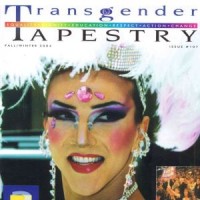Ten Years of Transgender Protests Against HRC— At An End? (2004)

©2004, 2013 by Dallas Denny
Source: Denny, Dallas. (2004, Fall/Winter). Ten years of transgender protests against HRC— at an end? Transgender Tapestry, 107, p. 17.
The initial layout of this issue included an article by Gwendolyn Smith, describing a recent protest in front of the HRC building, and an accompanying editorial that was hardly favorable toward HRC. The 7 August actions of HRC’s Board of Directors resulted in a last-minute change of content.
Transgender Tapestry Page (PDF)
Ten Years of Transgender Protests Against HRC— At An End?
By Dallas Denny
On Saturday, 7 August, the Human Rights Campaign announced its Board of Directors had voted to pursue only federal workplace protection legislation that is inclusive of gender identity and expression.
It was a landmark decision, as it reversed ten years of stonewalling (an apt term, that) and behind-the scenes deal-making by HRC to undercut and reverse the work of transgendered lobbyists to add inclusive language to the Employment Non-Discrimination Act.
HRC has been under pressure not only from the transgender community, but from its staff and financial contributors and local offices. The courageous stance of at least nine national GLBT organizations, spearheaded by the National Gay & Lesbian Task Force, publicly vowing they would no longer support a non-inclusive ENDA, and a renewal of protests by transgender lobbyists almost certainly contributed to the timing of the decision.
Some members of the transgender community have viewed HRC as an evil empire. This is, of course, not true. Several years ago, HRC changed its mission statement to be trans-inclusive. Even before that, it had worked hard on behalf of transgendered and transsexual people. It’s unfortunate and wrongheaded position on ENDA was not really representative of HRC’s position on transpeople, although the organization certainly showed a certain level of residual transphobia among its top echelon.
Finally, HRC has caved in on the thing transgender activists have most asked for. Now, we can no longer position them as the enemy. We must support them.
It is only fair and right that transgendered people begin to join HRC and make financial contributions. They have done good work. Now, they will do better work. Finally, they have lived up to their name: Human Rights Campaign.
A History of the Controversy
In 1995, not many people were on the Internet, but Sarah dePalma was. I believe it was she who checked her e-mail and brought the news to Phyllis Frye’s 1995 International Conference on Transgender Law and Employment Policy that lobbyists from the Human Rights Campaign Fund (as it was then called) had gone to Congressional offices just after transgender lobbyists Phyllis Frye and Jane Fee had visited. The HRCFers urged the bill’s supporters to remove the transgender-inclusive language Frye and Fee had persuaded them to include.
There were hasty strategy meetings at ICTLEP. A flyer was designed and printed, and attendees (myself included) each took one home and made hundreds of copies. The next week, at Pride events all across the U.S., transgender activists, many wearing Transexual Menace t-shirts, leafletted PRIDE attendees near the HRCF booths. The protests, which made national queer community news, came as a shock not only to the local HRCF people working the booths, but to staff at HRCF’s national offices.
Under fire from the transgender community, and under pressure from within, HRC began to change. It began to work with trans community leaders, and do trans-related educational work. Eventually, it even changed its mission statement. Still, the organization was recalcitrant with regard to its position on ENDA.
HRC placed so much spin on trans issues that it was difficult to tell whether and when the organization was sincere. For example, several years ago, HRC conducted focus groups in an attempt to determine the opinion of the American public about transgendered and transsexual people. Perhaps this was done in an honest attempt to gauge the reaction of the American public— or perhaps it was a cynical attempt to generate data to support HRC’s exclusion of transgendered people from ENDA. We’ll never know. If it was the latter, the plan backfired, for the data revealed that our approval and disapproval rates are virtually identical to those of gay men and lesbians. In other words, data generated by HRC itself suggested there is no rational basis for HRC’s position with regard to ENDA.
Pressure from transgender activists ratcheted up this spring, with Transgender Lobby Days. Gwen Smith’s article “Exclusionary Tactics” appeared in GLBT papers. The National Transgender Advocacy Coalition, The National Center for Transgender Equality, and assorted activists poured on the pressure.
On 7 August, HRC did the right thing. Let’s give them our support.
